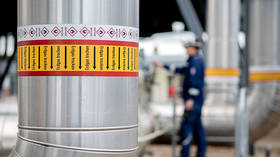Florida scientifically engineers insects to fight incurable citrus disease

Millions of Florida oranges are falling from the trees, unripe and green, plagued with a disease that is threatening to spread across the entire country. And although Florida is known for its citruses, the Sunshine State is quickly running out.
Huanglongbing, also known as citrus greening, has infected fruit-bearing trees in all 32 of Florida’s citrus-growing counties. The disease is caused by bacterium transmitted by insects called psyllids, which are nearly impossible to eradicate once they have settled. The small flying insects from Asia feed on citrus trees while depositing bacteria that starve them of their nutrients. Leaves turn yellow, roots decay, and bitter fruits fall off the dying branches prematurely.
The disease has no cure, and is quickly sickening citrus trees across Florida, where it first emerged in 2005. The Sunshine State is the second-largest producer of orange juice in the world, and Floridians fear that their $9 billion citrus industry could soon run dry, the New York Times reports.
“The long and short of it is that the industry that made Florida, that is synonymous with Florida, that is a staple on every American breakfast table, is totally threatened,” Sen. Bill Nelson, a Florida Democrat who helped obtain $11 million for research to fight the disease, told the Times. “If we don’t find a cure, it will eliminate the citrus industry.”
Florida’s citrus industry employs about 76,000 people, which would be out of a job if the trees stop producing eatable fruit. The industry has already taken a toll from a number of hurricanes, hard freezes and canker disease – which affects the vitality of citrus trees and also causes fruit to drop prematurely.
But citrus greening is the largest threat to Florida’s oranges, and the US Department of Agriculture has downgraded its crop estimates for five months in a row, analysts told the Times. The harvest season isn’t even over yet and the latest estimate is already down 10 percent from the first. Between 2006 and 2012, citrus greening has already cost Florida’s economy $4.5 billion and the loss of 8,000 jobs.
“We have got a real big problem,” Vic Story, head of a citrus-growing company, told the Times. “It’s definitely the biggest threat in my lifetime, and I’m 68. This is a tree killer.”
As a result of the bacterial fruit-killer, some growers have sold their groves or abandoned them, while others have simply given up replanting lost trees until the industry looks more promising.
But without a cure for citrus greening, there may be no hope for the industry. Recognizing the economic impact the collapse of this business, growers, researchers and lawmakers have spent millions on research for a cure – and plan to spend millions more.
Over the past six years alone, citrus growers have raised and spent $60 million to create a research foundation seeking to eradicate the disease. And this month, Florida lawmakers approved an $8 million fund for greening research. Nelson is also pushing for a bill in Congress to establish a research trust fund using tax funds from imported orange juice.
The research is becoming more important than ever as the disease spreads throughout the continental US. The disease-carrying psyllids have recently emerged in Texas, California, Arizona, Louisiana, Georgia, and South Carolina. The disease has already affected neighboring countries, including Mexico, Brazil, Cuba, and Belize.
Researchers at Washington State University have this month instigated a $9 million, five-year project to develop a new population of psyllids, which would be termed “nypsyllids”, to replace the disease-bearing ones.
“Our current strategies to control the psyllid are mainly focused on chemical control, parasites and predators that can provide some immediate control,” Harold Browning, chief operating officer for the project, told the Capital Press. The scientifically engineered insects would carry genes that make it impossible to transmit citrus greening.
The bacteria that causes the disease can lie dormant for five years, but once the symptoms begin to show on fruit-bearing trees, it may be too late to reverse the effects. Asian citrus psyllids can kill a tree in two years, and Floridians are under the pressure of time to find a cure for the disease before it causes the catastrophic collapse of their $9 billion industry.














